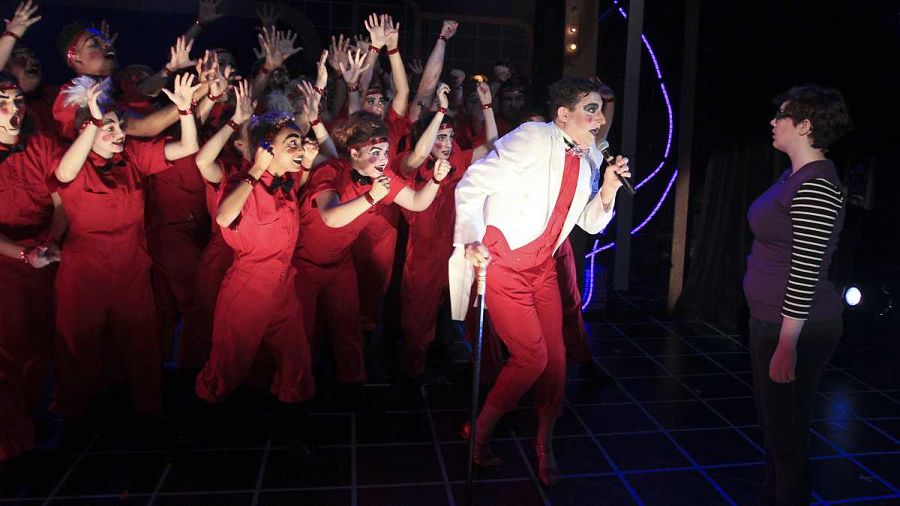From Fairmount to Fishtown, from Brewerytown to Bella Vista, from Mount Airy to Manayunk, from Old City to University City, the neighborhoods of Philadelphia were alive with the vibrant Fringe Festival in September. Celebrating its 20th anniversary, the “Philly Fringe,” as it’s fondly called, featured 157 events of wide variety between Sept. 9 and 24, including theatre, dance, music, performance art, installation art, and cultural exhibition.
What started in 1997 as a self-contained annual five-day festival has extended to three weeks and more, counting pre- and post-festival events. Along the way, the Fringe has acquired a building—an abandoned waterworks on North Columbus Avenue on the Delaware River—and expanded into a year-round operation called FringeArts, presenting in the building’s three performance spaces. Its annual budget has increased from $100,000 to more than $3 million. The growth has been phenomenal.
“We began performing in Old City’s empty warehouses,” explained Nick Stuccio, the Fringe’s dedicated producing director. “Over the years, we’ve performed on loading docks and bridges, in churches, row houses, parks, and empty lots. You name it, we use it. We even did a show in an abandoned Cadillac car once, as well as in the Sheraton Hotel swimming pool. Some shows, like Cell, traveled around the city while audience members got a call on their phones telling them where to show up.”
Modeled after the Edinburgh Festival Fringe, the Philly Fringe offers two kinds of productions: curated shows (both national and international), which are selected by Stuccio and his staff; and self-produced, unjuried shows. “We reach out to artists all over the city, encouraging groups to register,” explained Hallie Martenson, a festival spokesperson, about the latter group. “We give them exposure and provide them with a platform upon which to present their works.”
The festival places a high priority on nurturing relationships with local performing groups like Pig Iron, Renegade, and Headlong, many of whom got their start at the festival and whose work it continues to support. It also fosters partnerships with local institutions, like Opera Philadelphia and the University of the Arts.
This season I had the good fortune of seeing a wide variety of productions in an equally wide variety of locales, from a Navy Yard to a pier terminal to a century-old theatre to a square in South Philadelphia. As seen together, along with dozens of others, it was a rich experience, calling attention to a city, its assets, and its indomitable spirit. Below are some of the highlights.
The Elementary Spacetime Show
This wildly imaginative metaphysical vaudeville by César Alvarez addresses an unlikely topic for its form: teenage suicide. Performed by an exuberant ensemble of two dozen University of the Arts students, plus a handful of featured professionals, the show tells the story of Alameda (Julia Louis), whom we first see alone in her tiny kitchen. “There is a list of all the ways my life is no longer liveable,” she sings as she swallows a vial of pills. She faints on the kitchen floor and falls, Alice-like, through a rabbit hole into the altered reality of a garish game show set where her fate will be decided. Enter an androgynous Emcee (Salty Brine) in red sequins, high heels, and white tails, who invites Alameda to play, promising, “If you win the game, you get to choose whether you live or die.”
What follows is a series of games hosted by the Emcee and Esme (Electra Weston), a mysterious lady in white who becomes Alameda’s fairy godmother and spiritual guide. The existential riddles that Alameda must solve (“Suffering minus meaning equals hopelessness”) are accompanied by vibrant musical/dance numbers, performed by the talented ensemble and directed with verve and flair by Andrew Neisler. There are memorable cameo appearances by Hamlet (Michael Adrian Burgos), who delivers a hilarious riff on “to be or not to be,” as well as by Camus (an ironic Andrew Reiff). Along the way Alameda is guided through a spiritual revival meeting (preached by Andrew Farmer) and forced to confront a double of herself (Alameda #2, played by Marlee Gordon). The captivating musical score, the colorful mise-en-scène, and the fabulous young company delivered an original, inspiring, life-affirming evening of musical theatre.
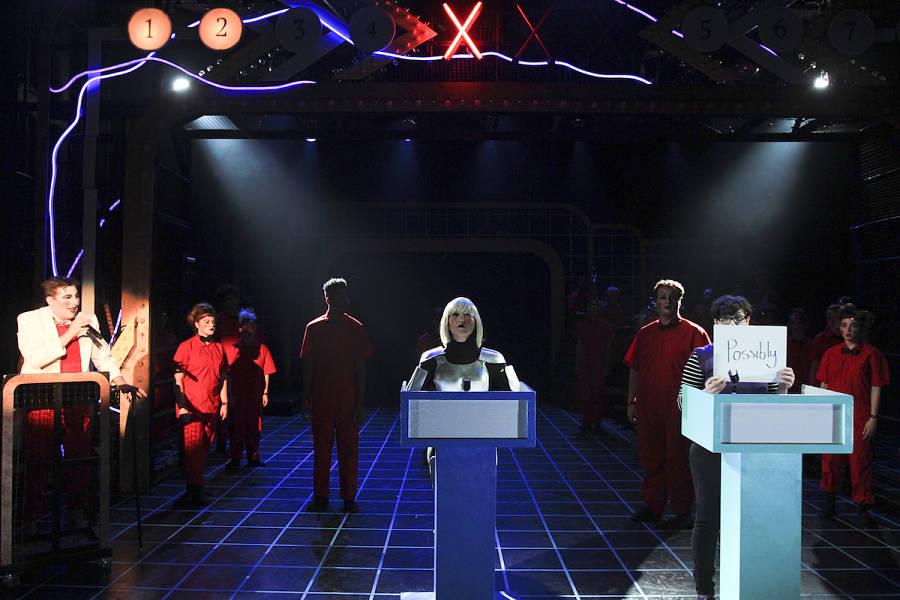
The Sincerity Project (2016)
Tucked away on fashionable Delancey Street in the tiny Plays and Players Theatre was another ensemble show, this time, on self-awareness and community. It’s the second devised by Team Sunshine Performance Corporation, whose founding goal is to meet every two years over the next two decades and each time stage an ensemble piece. This one (directed by Alex Torra) explores the nature of friendship and identity, with each of the seven ensemble members introducing themselves to the audience, showing us their tattoos, talking about their “first time,” and commenting on their relationships with other company members. The piece has a spontaneous, improvisatory quality, though actor Benjamin Camp kept an iPad handy to lead company members through a variety of physical sequences (for example, each actor undressed and dressed multiple times throughout the 90-minute performance).
This “getting naked” ritual might have reminded some Philadelphia audiences of Julian Beck and Judith Malina, whose company notoriously stripped down more than half a century ago at the Theatre for the Living Arts on South Street. But that stage nudity was an expression of protest and defiance; by contrast, Team Sunshine offers a gentle, natural, and often humorous ritual of undressing. Their nakedness also put me in mind of the words of Simon McBurney, whose company, Complicité, performed Mnemonic (1999), during which McBurney was naked for almost the entire show. “What does nakedness remind us of?” he asked the audience. “It reminds us that our fears are natural, our needs are clear. Seeing another naked body, we make an inventory of our own.” The Sincerity Project, like the song from The King and I, is all about “getting to know you” in a collaborative, compassionate theatrical context.
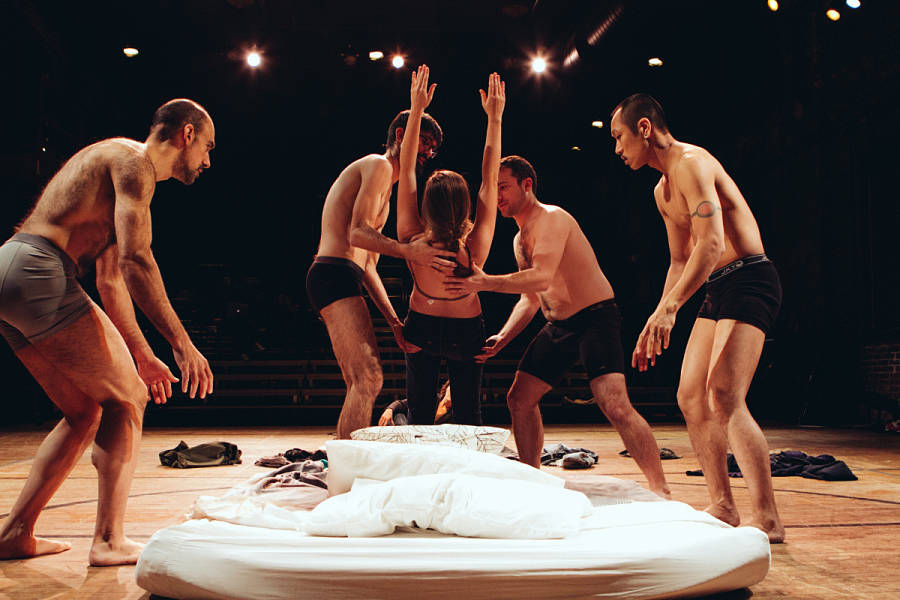
Julius Caesar. Spared Parts
The scene is a cavernous warehouse in Philadelphia’s Navy Yard. An audience stands in the middle of an empty, stark-white enclosure, watching avant-garde Italian director Romeo Castellucci and his company’s radical deconstruction of Julius Caesar. As its subtitle suggests, it’s a “dramatic intervention on W. Shakespeare,” one that mercilessly assaults an audience struggling to understand the director’s intentions. As such, it fits theatre director Peter Brook’s description of “theatre of cruelty.”
In the beginning moments, Castellucci sets the tone for a traumatizing theatre experience that will shock as much as confound. Following a sudden, deafening noise, three actors (members of Societas Raffaello Sanzio) enter and set up an electronic contraption on a large white plinth at centerstage. It turns out to be a surgical endoscope, which one actor inserts into his mouth, while the audience watches in dread. Immediately, a huge, appalling image of the actor’s larynx is projected on an upstage screen. “You cruel men of Rome,” he begins, speaking (somehow) in Italian, reciting a few of Shakespeare’s lines (the translation is projected on the screen as well) while we watch the repellent image of his contracting voice box, resembling a grotesque pair of lips. And off we go, on a bizarre 45-minute journey of jolting sounds and visceral theatre imagery.
One baffling scene follows another: An older actor, presumably Caesar, enters in red robes, accompanied by more ominous sounds (drums? thunder?). Simultaneously an actor leads in a huge black horse onstage, which proceeds to defecate (was this scripted too?). Another man paints two cryptic words on the horse in bold white letters (“Menetekel Peres”). Next, what’s meant to represent the actual assassination takes place, involving a rubber breast attached to Caesar’s chest. We watch in disbelief as an actor (Brutus, probably) sucks at the breast, which eventually falls to the ground, followed by Caesar himself. After his dead body is shrouded in the red robes, another actor delivers excerpts of Mark Antony’s speech—except that the actor seems to have had a tracheotomy and therefore can only utter gargling sounds through his throat.
In the final moments, we hear sounds of a voice shouting from an offstage loudspeaker (Mussolini’s, perhaps?). I, for one, left feeling disoriented and disturbed. I was later told that the words painted on the horse meant “I bring death” in an archaic Biblical language. Even without that translation at hand, the audience got the message, in this alienating theatre of images.
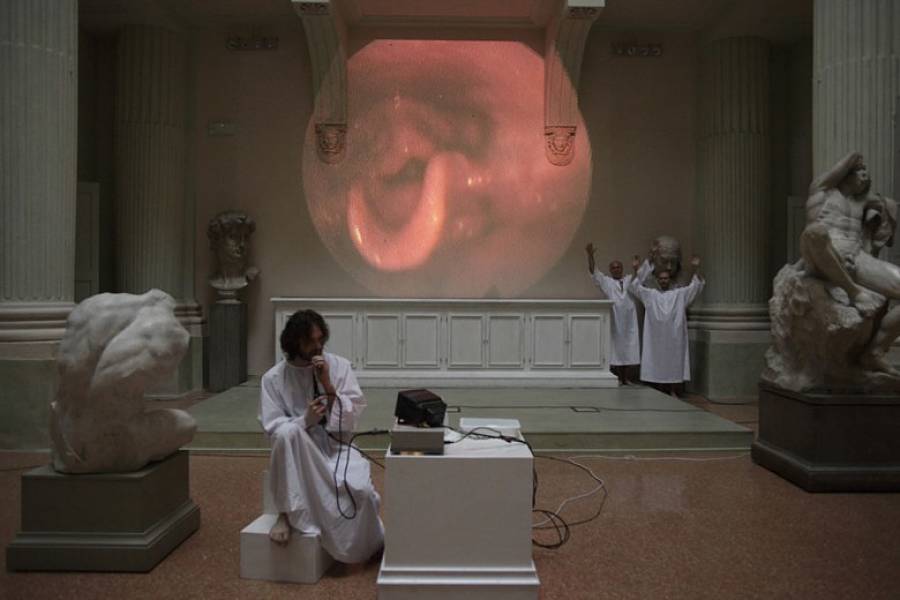
King John
After the rarefied esoterica of the avant-garde, it was a relief to join “the masses” in Hawthorne Park on 12th and Catherine in South Philadelphia for a breath of fresh air and equally fresh theatre energy. Revolution Shakespeare, a lively young professional theatre troupe, sets Shakespeare’s play of war and intrigue in a future dystopian world. A powerful new ruler (King John, played by Kevin Bergen) has taken over, but is soon challenged by daring “Philip the Bastard” (Carlo Campbell), who seeks to overthrow him and restore honor to the land.
As directed by Dan Kern, the company’s rock band (playing original, “trip-hop” music) was perched on a stand at the corner of the park, before which the actors (also band members), clad in eclectic costumes, told the Bard’s story. King John wore a crown consisting of crushed Pabst Blue Ribbon beer cans stapled together. The promise of an apocalypse was never so entertaining.
What I savored most about the show was the experience of seeing it on that warm Saturday evening. Neighbors came out of their houses and sat on stoops to watch the performance. Families with strollers picnicked on the lawn. Bicyclists and pedestrians stopped at the ticket desk (admission: free), where helpers encouraged them to register to vote in the upcoming presidential election, as well as buy company T-shirts. My husband and I opened the back of our SUV, and sat on the tailgate to watch the action. This was what Peter Brook calls “immediate theatre”: organic, vital, and communal.
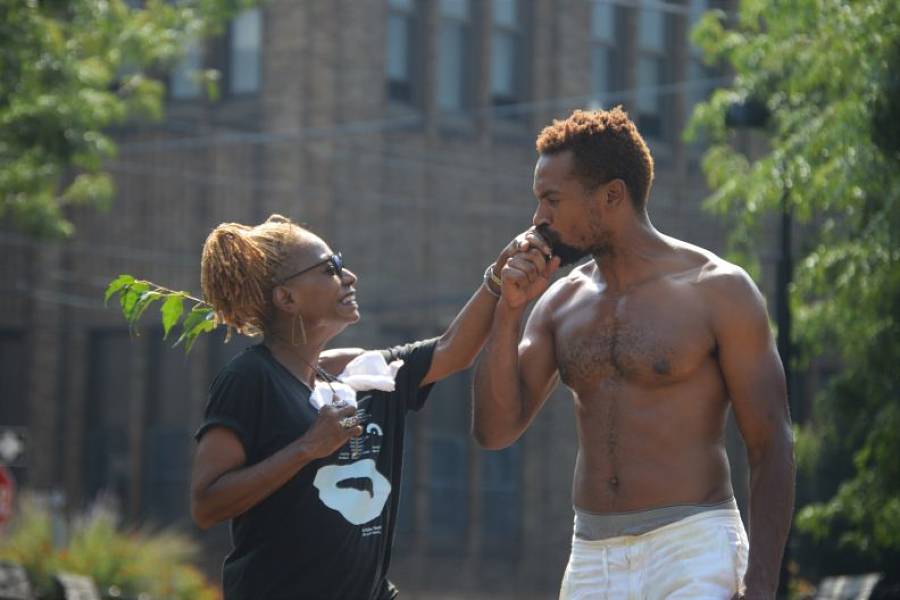
Third World Bunfight Macbeth
What a pity that this electrifying production of Verdi’s Macbeth, adapted by Fabrizio Cassol and copresented with Opera Philadelphia at the Prince Theatre, ran only for two nights at the Festival’s end! Conceived, designed, and directed by Brett Bailey, this sensational production is set in 2004, in war-torn Goma, a city in the Democratic Republic of the Congo.
Third World Bunfight is a South African-based company dedicated to urgent political theatre. Their arresting reimagining of Shakespeare’s story features a Congolese warlord and his ambitious wife, who, in their quest for power and profit, murder their leader and commit mass atrocities in the province they seize.
Performed with passion and urgency by an all-black cast, the production features a seven-member chorus stage right and a 10-piece orchestra stage left. The action is played downstage before a huge screen upon which images of violence are projected, including fists, knives, and skulls. Macbeth (Owen Metsileng) and Lady Macbeth (Nobulumko Mngxekeza) are a ferocious pair; he wears a crown shaped in a fist, she bears a huge rifle and a defiant gaze. As they steep themselves in blood, they change into undershirts and army fatigues, while the three witches wear white masks and helmets. Macbeth’s henchmen dance like the Four Tops and the Temptations, adding a jarring touch of popular culture. It’s a mélange of contemporary style elements, which, when blended with Shakespeare’s story and Verdi’s passionate music, create a work of powerful impact.
In a final tableau on the upstage screen, the three witches become white birds who merge to become the logo of Hexagon, a controversial multinational company that the play portrays as making huge profits from mining the region while exploiting innocent men, women, and children forced to work at gun point by local militia groups.
This Macbeth is among a number of recent productions of the classics set in war-torn Africa (witness Classic Stage Company’s 2016 production of Brecht’s Mother Courage). In the case of Third World Bunfight, the artistic collaborators have painful firsthand knowledge of that battered continent.
Looking Ahead
Plans for the 2017 Festival are already underway. What are they looking for? Said Nick Stuccio, “We live in a land of contemporary art that can take many forms. We’re drawn to interdisciplinary, nonlinear, free-thinking, experimental work. As in science, we look for breakthroughs in art and culture that have meaning. We do a lot of devised theatre—a way of generating material that begins with a spark of an idea or a picture or a book or nothing, created by a group of artists. It’s a ‘lateral’ way of working—writer, director, actors, designers together—building from an idea rather than a script. What’s generated may be complex and enigmatic, but in the end it’s very rewarding.”
As a Fringe-sated audience member, I would agree.

